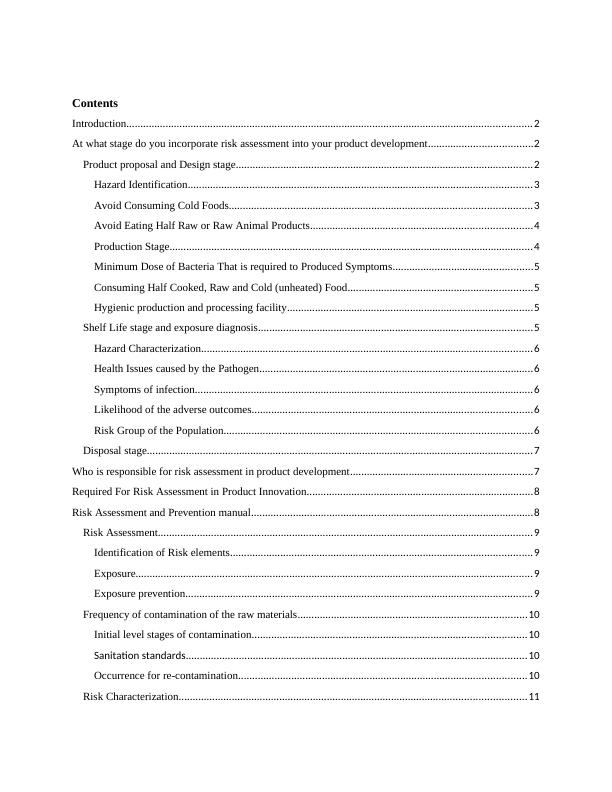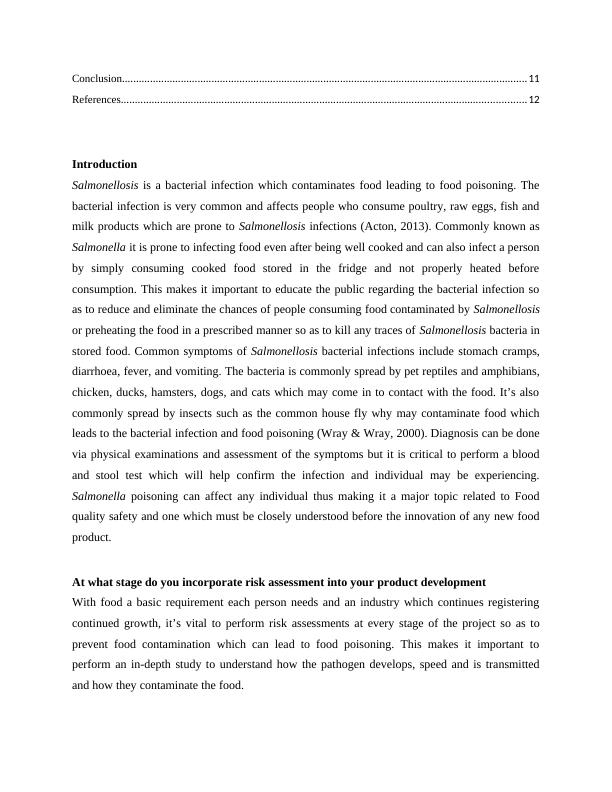Ask a question from expert
Food Safety Management Assignment
14 Pages4524 Words214 Views
Added on 2020-05-04
Food Safety Management Assignment
Added on 2020-05-04
BookmarkShareRelated Documents
Student NameSALMONELLOSIS: FOOD QUALITY SAFETYAND INNOVATION

ContentsIntroduction.................................................................................................................................................2At what stage do you incorporate risk assessment into your product development.....................................2Product proposal and Design stage..........................................................................................................2Hazard Identification...........................................................................................................................3Avoid Consuming Cold Foods............................................................................................................3Avoid Eating Half Raw or Raw Animal Products...............................................................................4Production Stage..................................................................................................................................4Minimum Dose of Bacteria That is required to Produced Symptoms..................................................5Consuming Half Cooked, Raw and Cold (unheated) Food..................................................................5Hygienic production and processing facility........................................................................................5Shelf Life stage and exposure diagnosis..................................................................................................5Hazard Characterization......................................................................................................................6Health Issues caused by the Pathogen..................................................................................................6Symptoms of infection.........................................................................................................................6Likelihood of the adverse outcomes....................................................................................................6Risk Group of the Population..............................................................................................................6Disposal stage..........................................................................................................................................7Who is responsible for risk assessment in product development.................................................................7Required For Risk Assessment in Product Innovation.................................................................................8Risk Assessment and Prevention manual.....................................................................................................8Risk Assessment......................................................................................................................................9Identification of Risk elements............................................................................................................9Exposure..............................................................................................................................................9Exposure prevention............................................................................................................................9Frequency of contamination of the raw materials..................................................................................10Initial level stages of contamination..................................................................................................10Sanitation standards..........................................................................................................................10Occurrence for re-contamination.......................................................................................................10Risk Characterization............................................................................................................................11

Conclusion.................................................................................................................................................11References.................................................................................................................................................12IntroductionSalmonellosis is a bacterial infection which contaminates food leading to food poisoning. Thebacterial infection is very common and affects people who consume poultry, raw eggs, fish andmilk products which are prone to Salmonellosis infections (Acton, 2013). Commonly known asSalmonella it is prone to infecting food even after being well cooked and can also infect a personby simply consuming cooked food stored in the fridge and not properly heated beforeconsumption. This makes it important to educate the public regarding the bacterial infection soas to reduce and eliminate the chances of people consuming food contaminated by Salmonellosisor preheating the food in a prescribed manner so as to kill any traces of Salmonellosis bacteria instored food. Common symptoms of Salmonellosis bacterial infections include stomach cramps,diarrhoea, fever, and vomiting. The bacteria is commonly spread by pet reptiles and amphibians,chicken, ducks, hamsters, dogs, and cats which may come in to contact with the food. It’s alsocommonly spread by insects such as the common house fly why may contaminate food whichleads to the bacterial infection and food poisoning (Wray & Wray, 2000). Diagnosis can be donevia physical examinations and assessment of the symptoms but it is critical to perform a bloodand stool test which will help confirm the infection and individual may be experiencing.Salmonella poisoning can affect any individual thus making it a major topic related to Foodquality safety and one which must be closely understood before the innovation of any new foodproduct.At what stage do you incorporate risk assessment into your product development With food a basic requirement each person needs and an industry which continues registeringcontinued growth, it’s vital to perform risk assessments at every stage of the project so as toprevent food contamination which can lead to food poisoning. This makes it important toperform an in-depth study to understand how the pathogen develops, speed and is transmittedand how they contaminate the food.

Product proposal and Design stageAt the product proposal stage Factors such as the ideal Ph. levels and temperature of the food,moisture content, safe storage duration, Hazard Identification, Hazard Characterization,Exposure Assessment, and Frequency of contamination and Risk Characterization are closestudies and understood. With a contamination and ph. level of 3.7- 9.5 and the bacterialinfection spreading at any temperature above 0 degrees, Salmonellosis possess a high risk ofcontaminating food products making in-depth research, analyses and prevention a priority. Thishelps educate the individual, stakeholders, and organization regarding the risks associated withthe proposed products development. It also helps identify the pathogens that are likely tocontaminate the proposed food product and how they may affect the proposed food innovationand help the business also develop a suitable product to develop. This stage is considered bymany food scientists to be the main stage of any food innovation, development, and productionmaking it important to expand on each of these areas from an in-depth perspective. This isessential as it allows the entrepreneur and innovator develop a detailed product risk table whichcan be used to design and develop the new food product.Hazard IdentificationThe main point linked to avoiding and preventing Salmonella bacterial infections and poisoningis first being able to understand the causes of the infection so as to prevent the hazards fromcontaminating food. Unlike a human being, many of our pets will usually put their mouth intoany old contaminated food item which we as human beings cannot consume. They then returnhome and put their mouth or touch our food leading to cross-contaminating the food we consume(UN, 2000). This makes it important to first manage the hazards associated with Salmonellapoisoning so as to reduce the risk of cross-contamination.Avoid Consuming Cold FoodsMany people and especially working professionals consider food to be safe due to having beencooked and stored in the fridge. Fridges do help prevent bacteria from multiplying and food fromspoiling but this does not eliminate or kill any Salmonellosis bacteria which may have found itsway into the food. This makes it critical for all food to be properly heated to help kill anybacteria which may have found its way or contaminated the food while cooling or before beingplaced in the fridge (Hardy, 2014). Avoid consuming cold food especially when has meat, egg,

End of preview
Want to access all the pages? Upload your documents or become a member.
Related Documents
Report on Salmonellosis: Food Quality Safety And Innovationlg...
|19
|4628
|30
Food Poisoning : Assignmentlg...
|1
|1848
|66
Risk and Crisis Managementlg...
|6
|1458
|38
Control Measures to Prevent Physical and Chemical Contamination of Foodlg...
|18
|728
|34
Study on Salmonella Typhimurium Bacteria: Reportlg...
|7
|1955
|50
Food Safety Managementlg...
|17
|664
|92